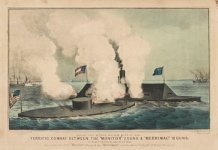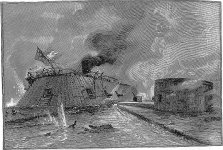jazzeum
Four Star General
- Joined
- Apr 23, 2005
- Messages
- 38,708
Last week on March 9 was the 150th anniversary of the legendary duel on March 9, 1862 between the ironclads, the Monitor and the Merrimack, a battle that changed naval history. The anniversary of this engagement has gone largely unnoticed.

The Monitor and the Merrimack (renamed the Virginia), go at it 150 years ago.
This battle has been recently recounted in the Disunion series, the Duel. In addition, Professor Brooks Simpson has written a brief article for the Library of America on the Battle of Hamption Roads.
By now, the story is well known. The Confederates took a sunken freight salvaged from the Gosport Naval Yards in Norfolk, Viriginia, the Merrimack, and turned it into an ironclad, renaming her the CSS Virginia. The U.S. Navy got wind of this and approved a design by John Ericsson.
The South wanted the Virginia to get down the Elilzabeth River into the Chesapeake as soon as possible, to sink the US squadron and disrupt George McClellan's plans offensive up the Virginia penninsula.
On March 8, the Virginia (which had some engineering problems: slow and hard to handle) sailed forth from the mouth of the Elizabeth River and feasted on the Yankee squadron. By the time the Virginia was done two ships were destroyed (the Cumberland and the Congress), three frigates aground (the Minnesota, Roanoke and St. Lawrence) and 400 Union sailors dead. The U.S. Navy would not suffer another defeat on this scale until Pearl Harbor.
Needless to say this caused a crisis in Washington; Lincoln convened a cabinet meeting, with everybody fearing the worst, that the Virginia would head north up as far as New York. The only one to remain calm was the Secretary of the Navy, Gideon Welles, who said that a deep draft vessel like the Viriginia would have trouble travelling far. He then let on that the U.S. Navy had an ironclad. This was the Monitor.
The Monitor, best described as a cheesebox on a raft, had set to sea on March 6, destination: the Chesapeake.
On March 9, as the Virginia was preparing to finish off the Minnesota, out came the Monitor, placing itself between the Minnesota and Virginia. The Monitor opened fire with one of its two guns, the Virginia responded and the battle was on. The ships kept steaming in circles, the Virginia in its large, ungainly arcs, the Monitor in sharper, tighter turns. As a result, the ships closed on each other, and then pulled apart; sometimes they shot at each other at a distance of 100 yards, and sometimes at 15 feet.

Battle between the Virginia and the Monitor, from an 1871 wood engraving (A.S. Barnes & Co)
After more than three hours, neither side had gained an advantage but each had sustained damage and the commander of the Monitor had been injured. The engagement was broken off.
Both sides claimed victory although it was more likely a draw.
Both ships never sailed again: the Virginia was eventually scuttled and the Monitor was lost in a storm. However, naval history had been made.

The Monitor and the Merrimack (renamed the Virginia), go at it 150 years ago.
This battle has been recently recounted in the Disunion series, the Duel. In addition, Professor Brooks Simpson has written a brief article for the Library of America on the Battle of Hamption Roads.
By now, the story is well known. The Confederates took a sunken freight salvaged from the Gosport Naval Yards in Norfolk, Viriginia, the Merrimack, and turned it into an ironclad, renaming her the CSS Virginia. The U.S. Navy got wind of this and approved a design by John Ericsson.
The South wanted the Virginia to get down the Elilzabeth River into the Chesapeake as soon as possible, to sink the US squadron and disrupt George McClellan's plans offensive up the Virginia penninsula.
On March 8, the Virginia (which had some engineering problems: slow and hard to handle) sailed forth from the mouth of the Elizabeth River and feasted on the Yankee squadron. By the time the Virginia was done two ships were destroyed (the Cumberland and the Congress), three frigates aground (the Minnesota, Roanoke and St. Lawrence) and 400 Union sailors dead. The U.S. Navy would not suffer another defeat on this scale until Pearl Harbor.
Needless to say this caused a crisis in Washington; Lincoln convened a cabinet meeting, with everybody fearing the worst, that the Virginia would head north up as far as New York. The only one to remain calm was the Secretary of the Navy, Gideon Welles, who said that a deep draft vessel like the Viriginia would have trouble travelling far. He then let on that the U.S. Navy had an ironclad. This was the Monitor.
The Monitor, best described as a cheesebox on a raft, had set to sea on March 6, destination: the Chesapeake.
On March 9, as the Virginia was preparing to finish off the Minnesota, out came the Monitor, placing itself between the Minnesota and Virginia. The Monitor opened fire with one of its two guns, the Virginia responded and the battle was on. The ships kept steaming in circles, the Virginia in its large, ungainly arcs, the Monitor in sharper, tighter turns. As a result, the ships closed on each other, and then pulled apart; sometimes they shot at each other at a distance of 100 yards, and sometimes at 15 feet.

Battle between the Virginia and the Monitor, from an 1871 wood engraving (A.S. Barnes & Co)
After more than three hours, neither side had gained an advantage but each had sustained damage and the commander of the Monitor had been injured. The engagement was broken off.
Both sides claimed victory although it was more likely a draw.
Both ships never sailed again: the Virginia was eventually scuttled and the Monitor was lost in a storm. However, naval history had been made.

